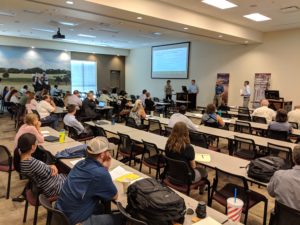Texas Watershed Planning Program reaches watershed coordinators statewide

COLLEGE STATION – Water quality in Texas begins in its watersheds, and the Texas Water Resource Institute, or TWRI, has benefited hundreds of communities around the state by training regional watershed coordinators and other professionals through its Texas Watershed Planning Program.
The TWRI is part of Texas A&M AgriLife Extension Service, Texas A&M AgriLife Research and Texas A&M University’s College of Agriculture and Life Sciences.
“Our Texas Watershed Planning Short Course provides needed training and sustainable proactive approaches to managing water quality throughout the state to watershed coordinators and other water resources professionals,” said Dr. Lucas Gregory, senior research scientist and quality assurance officer for TWRI.
This is the only watershed planning short course in the state, Gregory said, and so far more than 300 water professionals, including almost every watershed coordinator in Texas, have attended one of the 10 courses offered over the past decade.
He said the program’s goal has been to ensure watershed protection efforts are adequately implemented and to improve water quality restoration efforts statewide.
Dickie Clary, a Hamilton County Commissioner and landowner, attended the first short course in Bandera in 2008.
“The short course helped me learn the basics about surface water quality issues and provided useful knowledge about how watershed planning can be an effective tool in solving water quality impairments in local watersheds,” he said.
“It helped pave the way for a much broader understanding of various surface water quality issues and has undoubtedly helped me be more productive and successful in developing and advancing water quality programs that affect the citizens of Hamilton County.”
Gregory said the multi-day short course provides guidance on items necessary for an effective plan, stakeholder coordination, education and outreach.
“We strive to make sure the program meets the U.S. Environmental Protection Agency’s nine key elements of a watershed protection plan, ensure accurate data collection and analysis and provide the necessary tools for plan development,” he said.
Gregory said helping ensure the proposed protection plans meet EPA requirements is necessary to have watershed protection plans accepted and secure Clean Water Act funding.
“This training gives water professionals the tools they need to develop a protection plan they can use to conserve and protect the state’s water resources,” he said. “With the state’s ever-increasing population and other future demands on water resources, having these plans in place can go a long way toward making sure we are prepared to handle these future challenges.”

Gregory said over the past 10 years the program also has hosted 19 biannual Texas Watershed Coordinator Roundtables and 31 additional courses designed to increase watershed professionals’ expertise.
“During the 2018 fiscal year, we conducted two of the roundtables – one in Austin and one in College Station,” he said.
Gregory said the program also organized a week-long Texas Watershed Planning Short Course in Navasota and coordinated four different watershed trainings for professionals in Austin, Lewisville and College Station.
He said topics at the watershed trainings included watershed modeling, finding success for science through social media, fundamentals of developing a water quality monitoring plan, and agricultural and urban best management practices for watershed planning.
Gregory also noted the watershed planning website, http://watershedplanning.tamu.edu/, has had over 15,000 users and 36,063 unique page views since its launch. It currently has 394 subscribers to its watershed coordinators Listserv and 3,570 subscribers to the Natural Resources Training Newsletter.
The Texas Watershed Planning Program is currently funded through a Clean Water Act nonpoint source grant provided by the Texas State Soil and Water Conservation Board and EPA. It has received Clean Water Act funding through the Texas Commission on Environmental Quality in previous years.
Writers: Paul Schattenberg, 210-859-5752, [email protected]
Kathryn Wythe, 979-845-1851, [email protected]
Contact: Dr. Lucas Gregory, 979-845-7869, [email protected]



